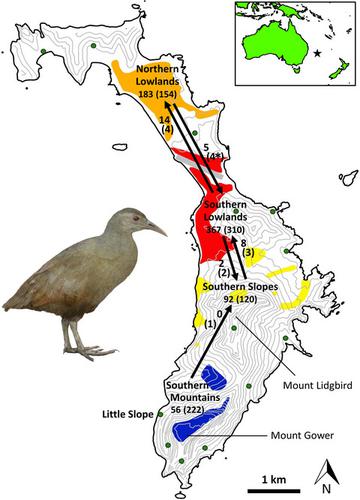当前位置:
X-MOL 学术
›
Anim. Conserv.
›
论文详情
Our official English website, www.x-mol.net, welcomes your
feedback! (Note: you will need to create a separate account there.)
Islands within islands: genetic structuring at small spatial scales has implications for long‐term persistence of a threatened species
Animal Conservation ( IF 2.8 ) Pub Date : 2020-06-20 , DOI: 10.1111/acv.12603 R. E. Major 1 , K. M. Ewart 1 , D. J. Portelli 2 , A. King 1 , L. R. Tsang 1 , T. O’Dwyer 3 , N. Carlile 3 , C. Haselden 4 , H. Bower 4 , D. E. Alquezar‐Planas 1 , R. N. Johnson 1 , M. D. B. Eldridge 1
Animal Conservation ( IF 2.8 ) Pub Date : 2020-06-20 , DOI: 10.1111/acv.12603 R. E. Major 1 , K. M. Ewart 1 , D. J. Portelli 2 , A. King 1 , L. R. Tsang 1 , T. O’Dwyer 3 , N. Carlile 3 , C. Haselden 4 , H. Bower 4 , D. E. Alquezar‐Planas 1 , R. N. Johnson 1 , M. D. B. Eldridge 1
Affiliation

|
Maintenance of genetic diversity within species is a key objective of biodiversity conservation, and small, isolated populations are particularly vulnerable to genetic erosion. Conservation management actions such as predator removal, captive breeding and reintroduction can facilitate numerical recovery of a population, but species often remain at risk from depleted genetic diversity and inbreeding. We investigated dispersal, genetic bottlenecks and genetic population structuring in the island‐dwelling Lord Howe woodhen, a species that came perilously close to extinction in the 1970s. Analyses of mark‐resighting records and variable genetic markers (single‐nucleotide polymorphisms) collected from the contemporary population and 100‐year‐old museum specimens found strong evidence of restricted dispersal at fine spatial scales, with both the contemporary and historic populations exhibiting strong population structuring between mountain and lowland/slopes sites. Additionally, genetic comparison of the contemporary population and historic specimens demonstrated a decline in genetic diversity over the past century. Specifically for the Lord Howe woodhen, we recommend ongoing genetic monitoring and translocations to increase genetic diversity within the re‐established lowland subpopulation. More generally, our results demonstrate how pronounced genetic erosion can arise in species subject to human persecution and predation by introduced predators, and how genetic fragmentation of natural populations can be present at fine geographical scales (less than hundreds of metres). Moreover, without prior information about genetic structure and subsequent genetic monitoring, conservation management can have unexpected negative consequences for the genetic health of populations. Therefore, genetic monitoring and management early in the recovery of populations is desirable to maximize their adaptive potential.
中文翻译:

岛屿内的岛屿:小空间尺度上的遗传结构对受威胁物种的长期存续具有影响
维持物种内的遗传多样性是生物多样性保护的一个主要目标,而孤立的小种群特别容易遭受基因侵蚀。诸如捕食者清除,圈养繁殖和再引入等保护管理措施可以促进种群的数量恢复,但是物种经常因遗传多样性枯竭和近交而处于危险之中。我们调查了居住在岛上的豪伍德伍德勋爵的传播,遗传瓶颈和遗传种群结构,该物种在1970年代濒临灭绝。对当代人群和100年前的博物馆标本收集的标记记录记录和可变遗传标记(单核苷酸多态性)的分析发现,有力的证据表明在精细的空间尺度上散布受到限制,当代人口和历史人口在山地和低地/坡地之间都表现出强大的人口结构。此外,对当代人口和历史标本的遗传比较表明,过去一个世纪遗传多样性有所下降。特别针对豪勋爵伍德伍德,我们建议进行持续的遗传监测和易位,以增加重建的低地亚种群内的遗传多样性。更普遍地说,我们的结果表明,在受到人类的迫害和掠食者掠食的物种中,遗传侵蚀是如何发生的,以及自然种群的遗传分裂如何能够在精细的地理尺度上(小于数百米)出现。此外,由于没有有关遗传结构和后续遗传监测的事先信息,保护管理可能会对人群的遗传健康产生意想不到的负面影响。因此,需要在种群恢复的早期进行遗传监测和管理,以最大程度地发挥其适应潜力。
更新日期:2020-06-20
中文翻译:

岛屿内的岛屿:小空间尺度上的遗传结构对受威胁物种的长期存续具有影响
维持物种内的遗传多样性是生物多样性保护的一个主要目标,而孤立的小种群特别容易遭受基因侵蚀。诸如捕食者清除,圈养繁殖和再引入等保护管理措施可以促进种群的数量恢复,但是物种经常因遗传多样性枯竭和近交而处于危险之中。我们调查了居住在岛上的豪伍德伍德勋爵的传播,遗传瓶颈和遗传种群结构,该物种在1970年代濒临灭绝。对当代人群和100年前的博物馆标本收集的标记记录记录和可变遗传标记(单核苷酸多态性)的分析发现,有力的证据表明在精细的空间尺度上散布受到限制,当代人口和历史人口在山地和低地/坡地之间都表现出强大的人口结构。此外,对当代人口和历史标本的遗传比较表明,过去一个世纪遗传多样性有所下降。特别针对豪勋爵伍德伍德,我们建议进行持续的遗传监测和易位,以增加重建的低地亚种群内的遗传多样性。更普遍地说,我们的结果表明,在受到人类的迫害和掠食者掠食的物种中,遗传侵蚀是如何发生的,以及自然种群的遗传分裂如何能够在精细的地理尺度上(小于数百米)出现。此外,由于没有有关遗传结构和后续遗传监测的事先信息,保护管理可能会对人群的遗传健康产生意想不到的负面影响。因此,需要在种群恢复的早期进行遗传监测和管理,以最大程度地发挥其适应潜力。











































 京公网安备 11010802027423号
京公网安备 11010802027423号